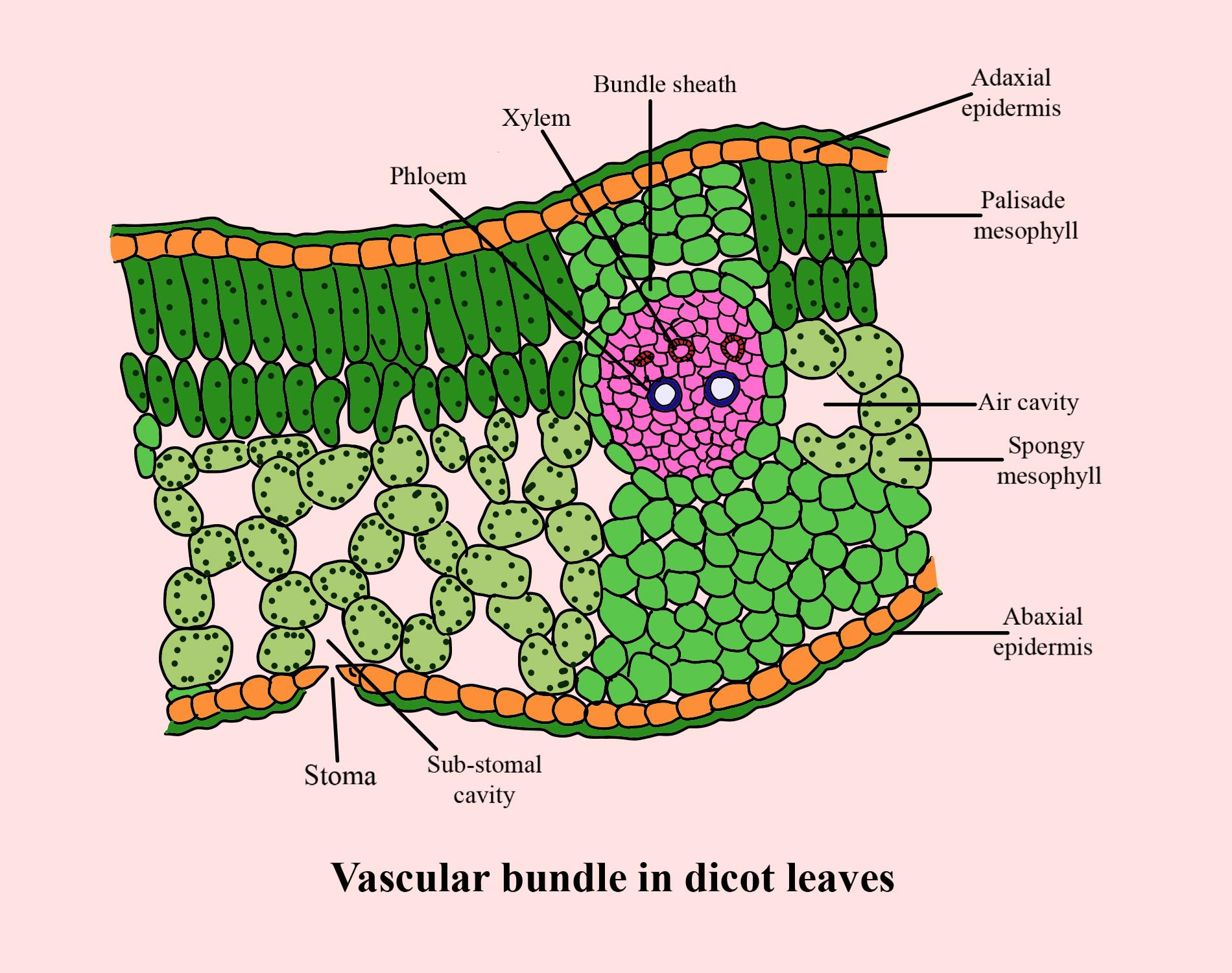
Vascular bundles in a dicot leaf are
(a)Conjoint, collateral, and open
(b)Conjoint, collateral, and closed
(c)Collateral and open
(d)Collateral and closed
Answer
552.6k+ views
Hint: A part of the transport system in the vascular plant which exists in two forms that are xylem and phloem constitutes a vascular bundle. They are generally found in monocots having phloem on the outer side with no cambium.
Complete answer:
Vascular bundles in a dicot leaf are conjoint, collateral, and closed. They are present within the mesophyll tissue which represents the midrib and veins of a leaf. They consist of xylem and phloem in each vascular bundle which is a complex tissue that is surrounded by a bundle sheath. Xylem and phloem are located on the same radius in a dicot leaf and the vascular bundle is described as conjoint and collateral. The presence of no cambium between the xylem and phloem describes the vascular bundle as closed. They provide strength to the leaf and helps in the transportation of water, minerals, and food in the leaf. The dicot plants constitute leaves which a relative Lee smaller and broader than the stomata which are kidney-shaped in dicot leaves. They consist of hypostomatic dicot leaves in which the stomata are present on the lower surface of the leaf. The leaves are dorsoventral and have a dark green upper surface with a light green lower surface.
Additional Information: Dicot leaves have large intercellular spaces due to the presence of mesophyll cells which are differentiated into two parts including the upper palisade and the lower spongy mesophyll. This constitutes reticulate venation in which there is a wave-like pattern with collenchymatous midrib. The bundle sheath is parenchymatous. The phloem and xylem are separated only by a few cells in the vascular bundles which help in the exchange of solute between two conducting systems for the regulation of long-distance transport.
So, the correct answer is 'Conjoint, collateral and closed'.

Note: Vascular bundle constitutes celery which is a collenchymatous tissue that provides support to the plant and is made up of elongated living cells that are filled with water and pressurized the water against the cell walls to create stiffness which gives the celery it's the crunch.
Complete answer:
Vascular bundles in a dicot leaf are conjoint, collateral, and closed. They are present within the mesophyll tissue which represents the midrib and veins of a leaf. They consist of xylem and phloem in each vascular bundle which is a complex tissue that is surrounded by a bundle sheath. Xylem and phloem are located on the same radius in a dicot leaf and the vascular bundle is described as conjoint and collateral. The presence of no cambium between the xylem and phloem describes the vascular bundle as closed. They provide strength to the leaf and helps in the transportation of water, minerals, and food in the leaf. The dicot plants constitute leaves which a relative Lee smaller and broader than the stomata which are kidney-shaped in dicot leaves. They consist of hypostomatic dicot leaves in which the stomata are present on the lower surface of the leaf. The leaves are dorsoventral and have a dark green upper surface with a light green lower surface.
Additional Information: Dicot leaves have large intercellular spaces due to the presence of mesophyll cells which are differentiated into two parts including the upper palisade and the lower spongy mesophyll. This constitutes reticulate venation in which there is a wave-like pattern with collenchymatous midrib. The bundle sheath is parenchymatous. The phloem and xylem are separated only by a few cells in the vascular bundles which help in the exchange of solute between two conducting systems for the regulation of long-distance transport.
So, the correct answer is 'Conjoint, collateral and closed'.

Note: Vascular bundle constitutes celery which is a collenchymatous tissue that provides support to the plant and is made up of elongated living cells that are filled with water and pressurized the water against the cell walls to create stiffness which gives the celery it's the crunch.
Recently Updated Pages
Master Class 11 Business Studies: Engaging Questions & Answers for Success

Master Class 11 Computer Science: Engaging Questions & Answers for Success

Master Class 11 Maths: Engaging Questions & Answers for Success

Master Class 11 Chemistry: Engaging Questions & Answers for Success

Master Class 11 Economics: Engaging Questions & Answers for Success

Master Class 11 Accountancy: Engaging Questions & Answers for Success

Trending doubts
What is meant by exothermic and endothermic reactions class 11 chemistry CBSE

10 examples of friction in our daily life

One Metric ton is equal to kg A 10000 B 1000 C 100 class 11 physics CBSE

1 Quintal is equal to a 110 kg b 10 kg c 100kg d 1000 class 11 physics CBSE

Difference Between Prokaryotic Cells and Eukaryotic Cells

What are Quantum numbers Explain the quantum number class 11 chemistry CBSE




